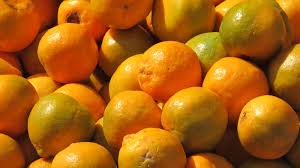While tangerines and oranges are closely related, they are actually two separate fruits with some notable differences.Orange is known to have several health benefits and is among the most popular fruits around the world.
Oranges can be had not only as a snack but also as a major recipe ingredient in various dishes. Nowadays orange juice is an integral part of a healthy breakfast thus promoting a healthy start to the day. They’re mainly available in two categories — sweet and bitter, with the former being the type most commonly consumed. Generally an orange should have smoothly textured skin and be firm and heavy for its size. These will have higher juice content than those that are either spongy or lighter in weight.
This article explains the key similarities and differences between tangerines and oranges.

Tangerines and oranges have similar qualities because they are members of the same family.
They may look alike, but they are actually two different species of fruit with separate origins and varieties.
Tangerines
Tangerines were first grown in Palatka, Florida. In the 1800s, they received the name “tangerine” because they were imported through the city of Tangier in Morocco.
Like oranges, tangerines are members of the citrus family, but they are the fruit of the C. tangerina species.
Tangerines are often labeled as mandarins, or vice versa, especially in the United States.
However, from a botanic standpoint, tangerines refer to a subgroup of mandarins. Most commonly, mandarins that are reddish-orange and brightly colored tend to be labeled as tangerines.
Tangerines are typically in their prime from late October through January.
Oranges

Oranges originated many years ago in Asia, most likely in Southern China and Indonesia. Today, the vast majority of oranges are produced in Florida and Sao Paulo, Brazil.
They are the fruit of the Citrus x sinensis species and are also members of the citrus family.
Interestingly, oranges are hybrids of two fruits: pomelo and mandarin.
There are many different varieties of oranges. They can be divided into four classes, each with identifying characteristics:
- Common or round: There are numerous varieties of common oranges, including Valencia, Hamlin and Gardner. The majority of oranges in this class are used for juice production.
- Navel: Arguably the most common class of orange, this type actually grows a second fruit at the base which resembles a human belly button. Cara cara is a popular type of navel orange.
- Blood or pigmented: With high concentrations of anthocyanin, a type of antioxidant pigment, blood oranges have a dark red flesh. The rind can sometimes possess darker red spots as well.
- Acidless or sweet: This class of orange has very low levels of acid. Given their low acid concentration, these oranges are predominantly eaten and not used to make juice.
Peak orange season varies based on the variety. However, most oranges are in their prime from November through March.Different Appearances
Different Appearances
The main distinction between tangerines and oranges is size.
Oranges come in different sizes and slightly different shapes, depending on the variety. However, as a rule of thumb, oranges grow to a larger size than tangerines.
Sometimes referred to as “baby oranges,” tangerines are smaller, somewhat flattened and generally less rounded, making them a perfect pocket-sized snack.
Tangerines are also softer to the touch when ripe, while oranges are usually firm and heavy when ripe.
Both tangerines and oranges range from having many seeds to being seedless, depending on the variety. For example, navel oranges are seedless, while Valencia oranges have seeds.
Lastly, tangerines and oranges can differ in color.
Oranges are typically more yellow-orange, except for the blood orange, which has a dark red color.
Although tangerines are similar in color to most orange varieties, they are typically more reddish-orange.
Their Flavors Vary Slightly
The flavors of tangerines and oranges vary, but it depends largely on the variety of each fruit.
Both tangerines and oranges can be sweet or tart.
However, most tangerines are less tart and sweeter than oranges. Tangerines also tend to have a stronger flavor profile than oranges and a shorter aftertaste.
One exception to this is the blood orange. Blood oranges have a distinct flavor profile that differs from most varieties of tangerines and oranges.
Blood oranges tend to have a very rich taste that is not overly sweet with a hint of berry-like flavor.

Easier to Peel
The rinds of tangerines and oranges is another main difference between the two.
Both tangerines and oranges have a thin skin. However, oranges have a tighter skin and thus are usually more difficult to peel than tangerines.
Most varieties of tangerines have a very thin, loose skin, making it easy to peel. The peel is also pebbled and absent of any deep grooves.
Specifically, many tangerine varieties are known for their “zipper-skin,” meaning once the skin is torn, it slides off easily.
Very similar Nutrient Content
A whole tangerine has a high water content (85%), consists mostly of carbs (4% of daily value) and contains almost no fat.
Likewise, a whole orange has a high water content (87%), consists mostly of carbs (4% of daily value) and contains almost no fat.
The table below compares the nutrition of a 3.5-ounce (100-gram) portion of tangerine to the same serving of orange.
| Tangerine | Orange | |
| Calories | 53 | 47 |
| Carbs | 13.3 grams | 11.7 grams |
| Fiber | 1.8 grams | 2.4 grams |
| Protein | 0.8 grams | 0.9 grams |
| Fat | 0.3 grams | 0.1 grams |
| Vitamin A | 14% DV | 4% DV |
| Vitamin C | 44% DV | 89% DV |
| Folate | 4% DV | 8% DV |
| Potassium | 5% DV | 5% DV |
Overall, tangerines and oranges have similar nutrient profiles. However, tangerines tend to have slightly more calories per serving. They also contain a few more grams of carbs.
One notable difference between the nutrient profile of tangerines versus oranges is that oranges have more than double the amount of vitamin C.
Vitamin C is a powerful antioxidant that helps support connective tissues including skin, blood vessels and bones.
Oranges also have slightly more fiber than tangerines, making them a very good source of this beneficial carbohydrate.
That said, tangerines contain more vitamin A per serving. One 3.5-ounce serving of tangerine provides 14% of the daily value, while oranges offer 4%.
Both tangerines and oranges provide a good variety of nutrients, including potassium, thiamin and folate. Either fruit can be a nutritious, low-calorie addition to your diet

Potential Health Benefits
High in Vitamin C
Oranges are an excellent source of vitamin C. One orange offers 116.2 per cent of the daily value for vitamin C. Good intake of vitamin C is associated with a reduced risk of colon cancer as it helps to get of free radicals that cause damage to our DNA.
Oranges are a great source of highly absorbable vitamin C. Vitamin C is a water-soluble antioxidant that fights free radicals, which may play a role in cancer prevention.
The majority of the health benefits of oranges are likely linked to their high vitamin C content.
A handful of studies have looked at the effects of orange consumption, particularly orange juice consumption, on various health factors.
One study found that drinking orange juice decreased DNA damage. The study concluded that vitamin C, in conjunction with other plant compounds present in oranges, likely played an active role in the decrease in damage.
Another study found that people who drank two cups of orange juice daily for 12 months had lower “bad” LDL cholesterol levels and lower total cholesterol than non-orange juice drinkers.
Moreover, the Third National Health and Nutrition Examination Survey (NHANES III) evaluated data from over 6,000 people.
Those with the highest amounts of serum vitamin C had a significantly lower prevalence of Helicobacter pylori (H. pylori), a bacteria responsible for causing stomach ulcers.
Therefore, given the high vitamin C content in oranges, consuming oranges may be beneficial in preventing stomach ulcers caused by H. pylori.
Additionally, studies have shown that drinking orange juice may help prevent the formation of calcium oxalate and uric acid, which can contribute to kidney stones .
Note that most of these studies observed the effects of drinking orange juice. However, by eating oranges, you also benefit from the fiber, which is lost during juicing.
Both whole tangerines and oranges are high in fiber and relatively low in calories.
Studies have shown that eating a high-fiber diet may be beneficial for weight reduction, decreasing the risk of heart disease and improving blood sugar levels.
This makes tangerines and oranges a smart snack choice for a balanced, weight-reduction diet.
Benefits of eating oranges

The best way to eat both tangerines and oranges is to simply peel them and eat them.
Since tangerines are easier to peel, they can be used as a quick and easy snack, especially when you’re on the go. Both make great additions to salads, too.
When choosing a ripe tangerine, you will want to look for fruits that are deep in color, semi-soft and avoid those with brown spots.
Oranges don’t necessarily have to be bright in color to be ripe, but you will want to choose oranges that are firm and have smoothly textured skin.
Both tangerines and oranges can be stored on the countertop at room temperature or in the refrigerator, depending on your preference.
Healthy immune system
Vitamin C, which is also vital for the proper function of a healthy immune system, is good for preventing colds and preventing recurrent ear infections.
Prevents skin damage
Anti-oxidants in oranges help protect skin from free radical damage known to cause signs of aging. An orange a day can help you look young even at 50!
Keeps blood pressure under check
Oranges, being rich in Vitamins B6, help support the production of haemoglobin and also help keep blood pressure under check due to the presence of magnesium.
Lowers cholesterol
According to a study by US and Canadian researchers, a class of compounds found in citrus fruit peels called Polymethoxylated Flavones (PMFs) have the potential to lower cholesterol more effectively than some prescription drugs without side effects.
Controls blood sugar level
Fibre in oranges help by keeping blood sugar levels under control thereby making oranges a healthy snack for people with diabetes. Moreover, oranges have simple sugars. The natural fruit sugar in oranges, fructose, can help keep blood sugar levels from rising too high after eating. Its glycemic index is 40 and normally whatever foods fall under 50 are considered to be low in sugar. However, that does not mean you go about eating too many oranges in one go. Eating too much can spike insulin and may even lead to weight gain.
Lowers the risk of cancer
Oranges contain D- limonene, a compound that is touted to prevent cancers like lung cancer, skin cancer and even breast cancer. Vitamin C and antioxidants present in oranges are both important to build body’s immunity – they help in fighting cancer. The fibrous nature of the fruit also makes it cancer protective. According to a study, up to 15 per cent of cancer cases happen because of mutations in the DNA, which can be prevented with Vitamin C.
Alkalizes the body
While the basic nature of oranges is acidic before you actually digest them, they have a lot of alkaline minerals that play a role in the process of digestion. This property of oranges is similar to that of lemons, which are without doubt among the most alkaline foods.
Good eye health
Oranges are a rich source of carotenoid. The Vitamin A present in them play an important role in keeping the mucus membranes in the eyes healthy. Vitamin A is also responsible to prevent age-related mascular degeneration, which in extreme cases can lead to blindness. It also helps eyes to absorb the light.

Safeguards against constipation
Oranges have both soluble and insoluble fibre. This helps in keeping your intestines and stomach function smooth, preventing irritable bowel syndrome. Additionally, the fibre helps treat constipation to a greater extent.
Useful tip
Oranges like most citrus fruits, produce more juice when warmer — juice them when they are at room temperature. Rolling the orange under the palm of your hand on a flat surface will also help to extract more juice. Vitamin C gets destroyed fast when exposed to air, so eat an orange quickly once cut up.
History of oranges
Oranges have a very interesting history. The first set of oranges was grown in the north eastern part of India, southeast Asia and the south of China. They first cultivated in China in 2500 BC. It was in first century AD, that Roman took young orange trees from India to Rome.

Christopher Columbus planted orange orchards in Haiti. He had bought the seeds in 1493. By year 1518, Panama and Mexico also got their first taste of oranges and shortly thereafter Brazil started growing their own.
America plants its first orange trees in 1513. It was done by Juan Ponce de Leon, a Spanish explorer.
The sweetest variety of oranges are Valencia, bloody orange, Navel and the Persian variety.
The End Line
Tangerines and oranges are both members of the citrus family, but they are different fruits.
Tangerines appear to be a richer source of vitamin A, while oranges might offer more vitamin C and fiber per serving.
Oranges are also more rounded and larger, while tangerines are more flattened and petite, making them a great on-the-go snack.
Tangerines and oranges have their similarities and differences, but both are nutritious and a healthful addition to your daily diet.
